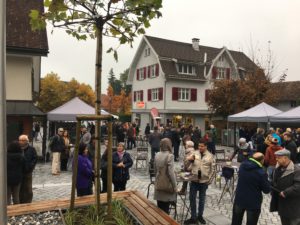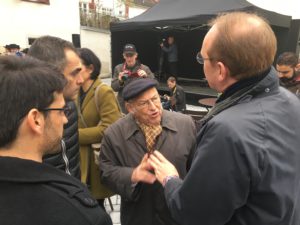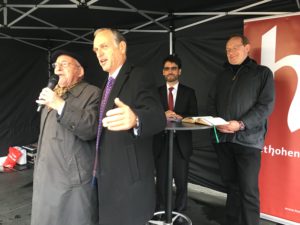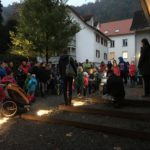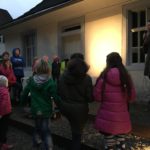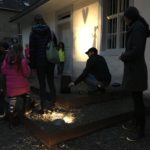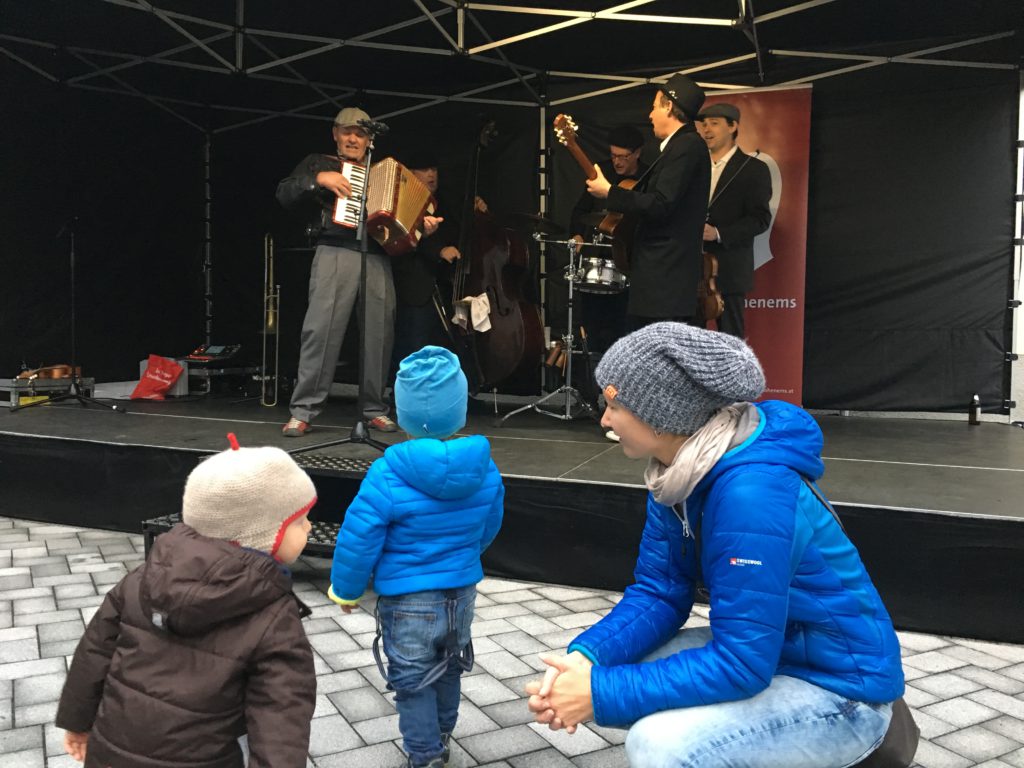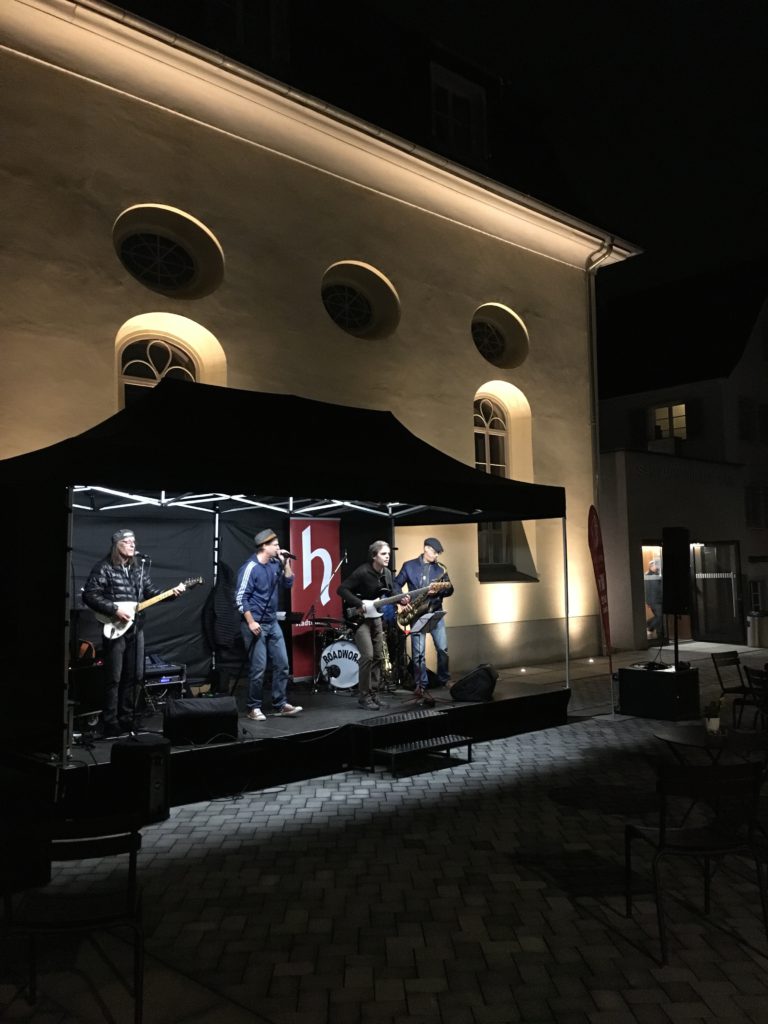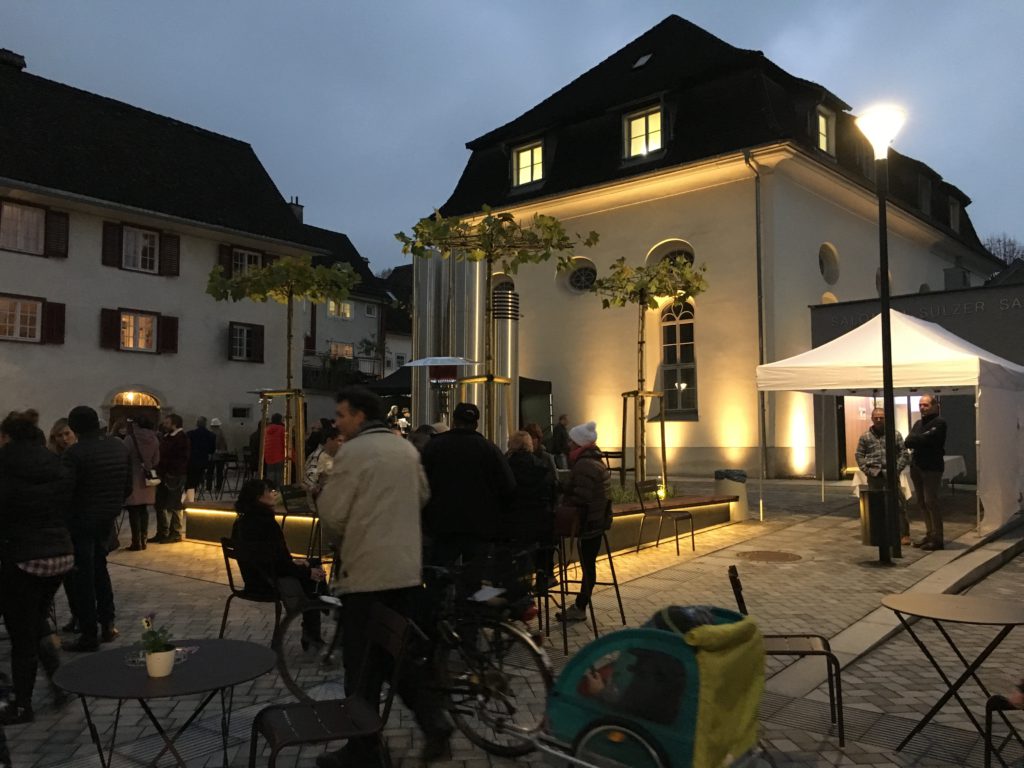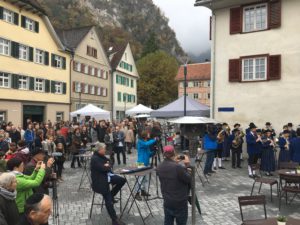
The invitation of the City of Hohenems was spiced with some involuntary irony: the new shared space in the Jewish quarter of the town was announced under the heading “The new Hohenems” as the “completion of the new Jewish quarter”. But no, Hohenems did not become the home of Jewish refugees and a newly built residential area for them. Its indeed the old Jewish quarter in the heart of town we talk about.
After many a year of discussion about the future shape of the towns center and its two streets, the old Jew’s lane and the old Christian’s lane, after public debates about alternative traffic solutions, neighbors protesting against still existing cross town traffic and local shops protesting against too much traffic calming, after a planning process of two years – and after half year of road work, the new design of the streets in the Jewish quarter is ready. And hundreds of Hohenemsers came to celebrate the 133.000 new cobblestones (all laid by hand), two fountains, benches and bike stands. An open square to fill with life, a space to share. And given the history of the quarter this also might be a space to share memories (pleasant and less pleasant), a multitude of heritages from diverse sources and conflicting ideas about the future.
The square in front of the synagogue now is the “Salomon Sulzer Square”. Once all the houses around the Hohenems synagogue had been the Salomon Sulzer Alley. Named after the cantor who left Hohenems young to become the chief cantor of Vienna, and soon to be a star in the Viennese music scene, adored by Schubert and Liszt. Sulzer became the major force of reform of Jewish liturgical music in the 19th century – and a prototype of a pop star, for the first time attracting Non-Jews to listen to Jewish tradition, while 50 years later sons of Jewish cantors made the next step, and left synagogue for Broadway. But that’s another story.
Mayor Egger headed the opening of the square and unveiled the plaque. But it was in fact his predecessor Richard Amann, who fought for a decent redesign of the public space in the center of Hohenems for years and finally succeeded to get the project on track.
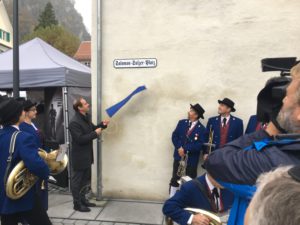
This celebration of the “Sulzer Square” though was also the moment to remember the history of street names. The old Jew’s lane of Hohenems in 1909 war renamed too: one part of the street memorialized the Hohenems’ Brunner family, who funded banks and insurance companies in Trieste, and played a role in liberal politics in Vienna, the other part remembered the Steinach family, three generations of medical doctors and scientists, with Eugen Steinach, the pioneer of hormone research being the last one of the family, dying in Exile. In 1938 the “Jewish names” were erased, the streets in the old Jewish quarter were now marked as “Friedrich-Wurnigk-Straße”, the name of the infamous Nazi-terrorist, who had murdered the head of the Innsbruck police in 1934, and now was a hero. In 1945, times obviously not ripe for a truthful exploration of the past, the street became the “Schweizer Straße”. One might guess how long it still will take to give the streets their name back. Let’s watch out for the future.
Michael Köhlmeier once dreamed of the “Hohenems Ring Parabel”, reminding Lessing’s plea for respect between the religions, as something coming to his mind, when standing once infront of the former Hohenems synagogue, when its still was the home of the fire brigade (between 1955 and 2000). And he did not forget to mention: its not just unsure who has the “right” ring, but Lessing was more radical. Probably the “original ring” is lost for long anyhow and we all play around with a substitute. When it came to blessings: the local Parish priest Thomas Heilbrun and Imam Seyran Ates gave them together with Rabbi Tovia Ben-Chorin from St. Gall (a rather uncommon pluralism still in Austria). And the agnostics would have their moment as well.
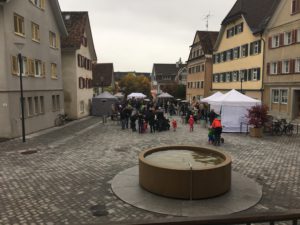
Three citizens were interviewed about their connection to this place. Pierre Burgauer though, is a citizen of St. Gall rather than Hohenems, today. He spoke how he found new connections to his roots in Hohenems through the activities of the Jewish museum in the last twenty-five years. His great-grandfather left his Hohenems mansion in the 1860s, offering the building to the Jewish community that turned it into the Jewish poorhouse. Today its one of the modest landmark buildings in the old Jewish quarter. Tudgce Celik spent part of her childhood in this house, not a poorhouse anymore but in poor condition, in the 1990s, as a child of Turkish immigrants, experiencing another form of otherness and cohabitation. The old Jewish quarter, bad in shape, was a territory of adventures for her – while today she is happy to work in the Jewish museum, when she is not studying in Innsbruck. Franz Sauer, active in the neighborhood today, politically and socially, told about his experiences with the new immigrants, and about his appreciation of their commitment to revive the old houses and to create something out of nothing.
School kids from the local primary school performed shadow plays – following stories by Monika Helfer – In front of the old Jewish school and the Villa Heimann-Rosenthal. It was a particular moving moment, when the little kids engaged in the Jewish history of the place with all their enthusiasm encouraged by the magic of light – and shadows. And this story has its shadows, they confronted as well. The city had invited cantor Shlomo Barzilai from Vienna, the late “follower” of Salomon Sulzer to accompany the ceremony. And the “Bauernfänger”, performing old songs with an ironic twist, and the “Bürgermusik” proudly presenting their folklore dress, they all led over into the party that followed, with a band named “roadwork”. In the end the Hohenemsers where dancing in the street. A day offering an outlook into another reality beyond the xenophobia and tension of today’s politics and resentments? A day of illusions?
Writing this the day America is going to vote and four weeks before Austria has to decide whether to elect a right wing populist who has no shame to support fascist views, is a challenge in itself.
In the middle of the Sulzer Square the art installation of Mariella Scherling is still present, though somewhat obscured, reminding everybody to the biblical quote that is more relevant than anything today: “Do not oppress a foreigner; you yourselves know how it feels to be foreigners, because you were foreigners in Egypt.“
